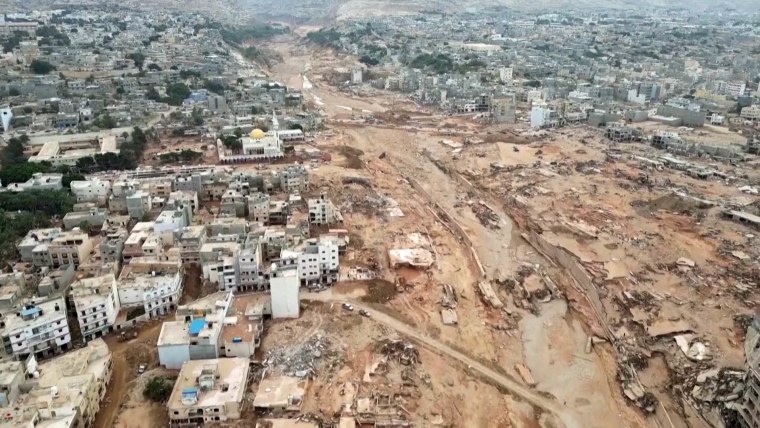
Thousands of people have been killed, with thousands more missing in the floods that survivors and experts told NBC News was not merely a natural disaster.
Years of civil war, corruption and institutional neglect left residents of the North African state at the mercy of Mediterranean storm Daniel’s extreme weather, as did the authorities who “frankly had nothing but contempt for their people,” said Tarek Megerisi, a Libya expert and senior fellow at the European Council on Foreign Relations, a think tank.
Fury that simmered for a week has now erupted into protests against local officials, with the home of Derna’s ousted mayor torched.
Here’s how the heavy rainfall turned so deadly in Libya.
From livestreaming to fleeing
The rain was getting heavier and heavier around midnight, but residents in the Wadi Derna Valley felt confident that the dams would hold — as they had before.
The two structures, Abu Mansour and Derna, were located just uphill from the Mediterranean coastal city and meant to protect its almost 90,000 residents.
The people were used to occasional flooding and on Sept. 10, even rain heavy enough to fill the first dam did not sound the alarm.
“We’re used to this … we’ve seen the same scene in 2011 without a catastrophe happening,” said al-Sharif, who was streaming it all live on Facebook as the canal started overflowing.
Residents took videos of the water level rising, then returned home to dry off and sleep as the night got darker and wetter.
But it was soon clear that this was not just another downpour.
“We started to hear screaming in the streets. ‘Torrent! Torrent is coming!’ So everyone went out onto their balconies to look, and we saw the torrent rushing into the streets with a very big force,” al-Sharif said.
It was about 2:30 a.m., he recalled, and cars were lying overturned on streets covered in mud. Thinking the worst was over, people headed out to clean up the roads.
Then “the tragedy happened.”
Around 3 a.m., it was clear both dams had given way as a second wave almost as high as the buildings in the neighborhood charged toward the residents, who ran to take whatever high ground they could and grab neighboring families to escape with them.
Some, like al-Sharif, were lucky to find their stairs taking them just out of reach of the water rushing up floor after floor behind them. After finally reaching the roof, he was shocked to see what was happening outside.
“The entire place was all submerged in water … you don’t see anything but water” he said.
“God had mercy on us,” al-Sharif said. “Our building survived, but the other buildings were completely wiped out. Taken away with the torrent like they were biscuits.”
Residents waited until 7 a.m. for the water to recede. Al-Sharif said he walked for two hours to find safety and aid, stalked all the way by the overwhelming tragedy. “The smell of death travels down all the roads,” he said.
But while for many residents, the water brought death to Derna in a devastating and sudden rush, the floods were preceded by a litany of unheeded warnings.
Missed warnings
In a research paper published last year, hydrologist Abdelwanees Ashoor of Libya’s Omar Al-Mukhtar University warned the Derna “area has a high potential for flood risk,” citing five floods that occurred there since 1942 and calling for immediate maintenance steps for the dams.
“In the event of a big flood, the consequences will be disastrous for the residents of the valley and the city,” he wrote in the Sebha University Journal of Pure and Applied Sciences.
Some Libyan officials have also not refrained from criticizing authorities.
The dams suffered major damage in a strong storm that hit the region in 1986, and more than a decade later a study commissioned by the government revealed cracks and fissures in their structures, Libya’s general prosecutor, al-Sediq al-Sour, said last week.
But years went by as cautionary reports piled up and restoration efforts either failed to get off the ground or were abandoned amid the chaos of civil war.
At a news conference in the stricken city, al-Sour said prosecutors would investigate the collapse of the two dams, as well as the allocation of maintenance funds.
“I reassure citizens that whoever made mistakes or negligence, prosecutors will certainly take firm measures, file a criminal case against him and send him to trial,” he said.
Survivors are in no doubt about what or whom to blame.
“The main cause of the disaster was the dam located south of Derna, which had not undergone recent maintenance,” said Salem Mansour, 27, who lost his sister in the disaster. Speaking from the hospital in the nearby city of Tobruk, he was convinced that more could — and should — have been done to prevent this.
“The responsibility lies with the successive corrupt governments in Libya, which neglected the safety of citizens, “ he added.

 Latest Breaking News Online News Portal
Latest Breaking News Online News Portal





